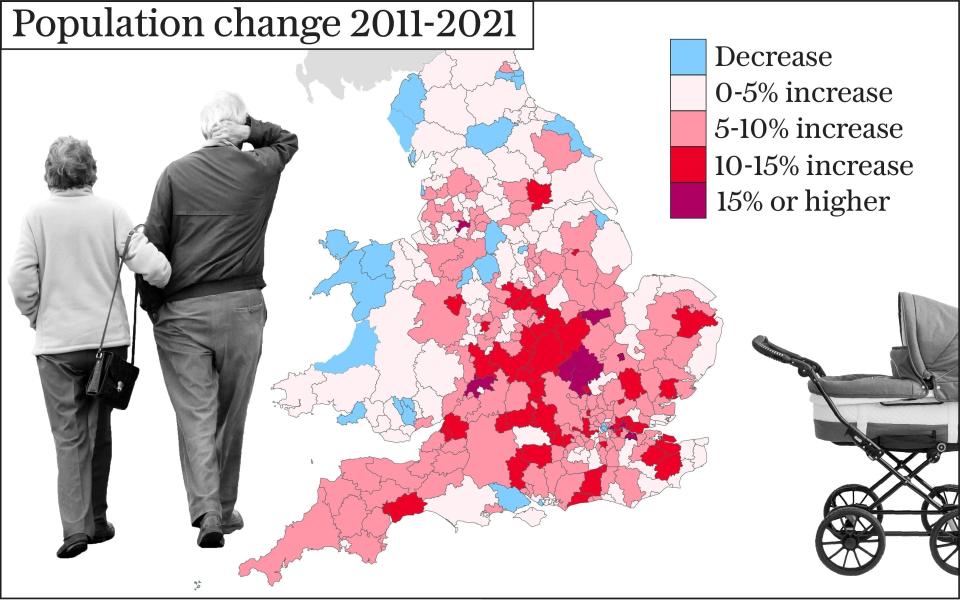Census 2021: Five insights into how we live now and search how your area compares

The first results of the census are in, highlighting a growing, ageing population.
Use our tool to find out how your area has changed.
1. The country is growing - but not everywhere
The population of England and Wales grew by 6.3 per cent over the past decade - or 3.5 million people.
But these changes have not been felt evenly. Across the south and east of England, the population of some areas has jumped by approximately 20 per cent as the London-urban sprawl continues.
Bedford and Dartford, increasingly popular for commuters, are amongst the biggest jumpers.
And Tower Hamlets, where there has been vast redevelopment over the past decade, has increased by more than 22 per cent.
The north of England and Wales continued a decades-long trend of stagnant growth compared with the rest of the country, with the North-East increasing by just two per cent.
The declining opportunities in areas such as Redcar, Sunderland and Gateshead mean populations there have fallen significantly since the 1980s.
That trend has only continued over the past decade in some areas, highlighting the difficulty the Government has had in making the often-mooted “Northern Powerhouse” a reality.
But the biggest declines since the last census were in Kensington, Chelsea and Westminster. Remember, this census was during the pandemic in March last year. Is it possible that these drops highlight the ability wealthy west Londoners had to flee the city as lockdowns began?
2. The population is greying quickly...
The census confirmed that England and Wales are rapidly greying.
In 2021, some 18.6 per cent of the population were over 65. This is a big jump when compared to the previous few censuses, where the proportion of older adults has stayed between 15 and 16 per cent.
Unsurprisingly, coastal and rural areas have maintained the trend of being both the oldest and fastest ageing areas.
North Norfolk, Rother and East Lindsey, for example, have become the first places in England and Wales where the proportion of pensioner-aged adults has exceeded 30 per cent.
Rural areas have also recorded some of the quickest ageing over the past decade.
Just over one in five adults were aged over 65 in Derbyshire Dales a decade ago, but now that number is as high as 28 per cent.
All of this will have a serious knock-on effect, not just on the need for public services but also how an area develops in the future.
3. ...But not everywhere is ageing
Urban areas are dominated much more by younger people. Of the top 10 areas with the fewest elderly people, just one is outside London - Manchester.
Tower Hamlets has become the first local area in England and Wales where the proportion of over-65s has dropped below six per cent in at least 40 years.
Overall, the number of over-65s has declined in just 11 of 331 local authorities over the past decade, including Salford, Luton and Cambridge.
Look back even further and the census highlights how quickly living trends can transform an area.
In 1981, almost a quarter of people in Brighton and Hove were over 65. Now, spurred on by commuters and its hip reputation, just 14 per cent are elderly.
4. Young adults are leaving parts of London and Home Counties
Young adults tend to move about the country based on a number factors, ranging from job opportunities to affordability.
And if house and rental prices are anything to go by, west London and its commuter hubs have seen an exodus in the past 10 years.
Woking, Richmond-upon-Thames, Windsor and Hammersmith are amongst the areas where the number of 20 to 40-year-olds have declined by around 10 per cent - despite the overall population increasing.
On the flipside, other areas are benefiting from the rejuvenating impact on an increase in younger adults.
Salford, which has seen an influx of media jobs in the past 10 years, has recorded a rise of almost 30 per cent in its young adult population. This surge in young people has also extended to East Devon, South Gloucestershire and South Norfolk.
5. The areas where one sex dominates
As a whole, England and Wales is more female than male.
Just 11 places have more men than women, including rural Rutland and Richmondshire, but also Cambridge and Southampton.
Young single men and women might look to the census as an indicator for where they should head if they are looking to couple up.
In Rutland and Richmondshire, almost 60 per cent of 20 to 30-year-olds are men.
Meanwhile, Wandsworth, Camden and Islington have the highest proportion of women - some 55 per cent of young adults are female.

 Yahoo Movies
Yahoo Movies 